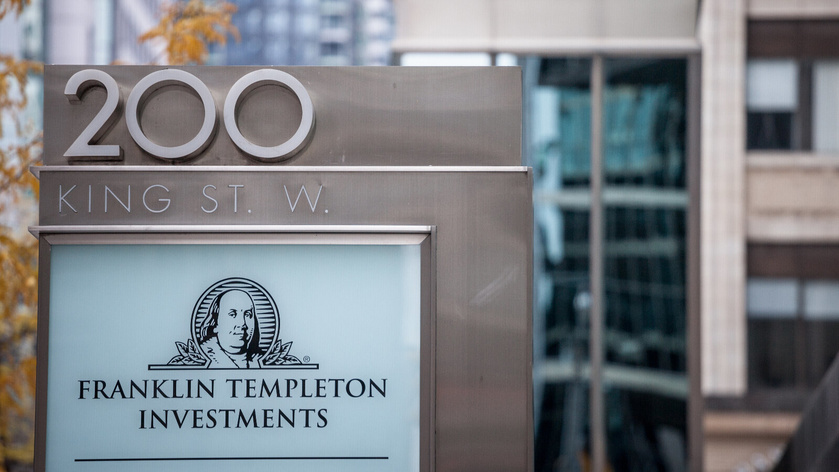- Future crypto products “could take many forms” based on how regulatory environment evolves, according to the firm’s head of digital assets
- The firm’s clients are seeking a streamlined process to invest in this space
Franklin Templeton is exploring ways to bring additional digital asset investment strategies to market following the launch of its crypto-focused separately managed accounts (SMAs) last month.
Roger Bayston, the company’s segment lead, called digital assets “frontier risk alternatives” in a recent interview with Blockworks.
Franklin Templeton had roughly $1.3 trillion in assets under management, as of Sept. 30. One of its new crypto-focused SMAs invests in 10 to 15 of the largest digital assets, excluding stablecoins and meme coins. Its other takes a similar approach, but bitcoin and ether are both capped at 25% of the portfolio.
The products come as institutional adoption of crypto is on the rise, according to a recent Fidelity survey, with 74% such investors saying they plan on buying digital assets in the future.
Bayston said in May that crypto was an asset class with “a great deal of thematic tailwinds,” as industries begin to unlock the potential of blockchain.
More recently Sandy Kaul, Franklin Templeton’s senior vice president of digital assets and industry advisory services, published research about, in part, how decentralization is poised to disrupt traditional finance over the next decade.
Blockworks checked back in with Bayston about what’s next.
Blockworks: Following the launch of crypto-focused SMAs, what other types of crypto offerings might the firm be looking to offer?
Bayston: We are committed to providing industry relevant opportunities to meet the evolving investment needs of our clients.
Our robust team of investment talent provides deep tokenomics research for our strategies, which are managed on a proprietary management platform built from the ground up. This gives us the expertise to offer the best advice and active management possible for our clients.
We are continuing to develop delivery mechanisms to deliver digital asset investment strategies for a variety of investors.
Blockworks: Could these include more SMAs? How about crypto-related ETFs?
Our experienced investment team has created many portfolio strategies utilizing various degrees of discretionary decision-making and research intensity.
Given the ripe field of innovation that blockchain technologies offer, you can expect Franklin Templeton to continue to bring relevant product ideas to the market. These products could take many forms based on current or future regulatory permissions.
Blockworks: What is the firm hearing from clients right now in regards to crypto?
Bayston: We believe that digital assets are frontier risk alternatives – new investable opportunities that capture the return streams of novel business models and can generate long-term growth.
We are seeing investors with a variety of interest, experience and exposure levels with these assets across the world and the desire for sound investment advice.
We are hearing from clients on the need for a streamlined process to invest in this space, founded on deep asset research and professional portfolio management, in order to generate the highest capital appreciation with an eye on risk management.
Blockworks: What are your thoughts on the Ethereum Merge? How could it impact adoption?
Bayston: The transition to a proof-of-stake protocol illustrates the continuous innovation we see with blockchains, but more specifically represents a major software upgrade for the network with the possibility for improved security and capital and energy efficiency.
A resulting outcome of this event is a major reduction in Ethereum’s carbon footprint, which is desirable to appeal toward institutional ESG [environmental, social, governance] mandates. The evolution of Ethereum is an example of how this technology continues to evolve. Our investment platform will also evolve as the platforms grow and innovation in this space continues.
Blockworks: What crypto trends is Franklin Templeton most focused on right now?
Bayston: We believe that mass adoption of digital assets likely starts with the tokens themselves, and inclusion of these assets in investment portfolios will pave the way for other use cases for blockchain technology.
The digital asset space can bring two broad themes to investment management: expanding the opportunity set for investment options to include the blockchains themselves or bringing assets on chain in a more fungible way, and using the blockchain rails to create operational efficiencies across traditional asset management processes.
Blockworks: What does the company expect from a crypto regulatory perspective in the coming months? How might it be engaging to influence policy in the segment?
Bayston: There is substantial global regulatory development with digital assets in a variety of geographies, and we believe regulators are conducting their due diligence to take a measured approach to regulation.
We are comfortable navigating the global regulatory environment as it develops around the world. We’re a collaborator with regulators, given our focus on providing the best advice and service to our clients and view that the future of asset management includes blockchain technology and digital assets.




























